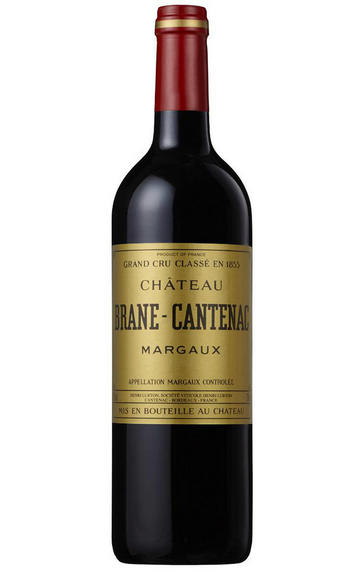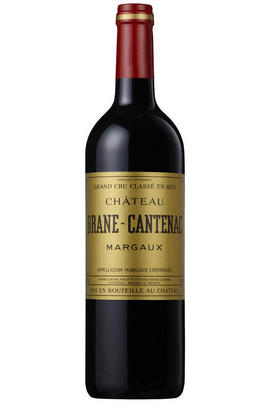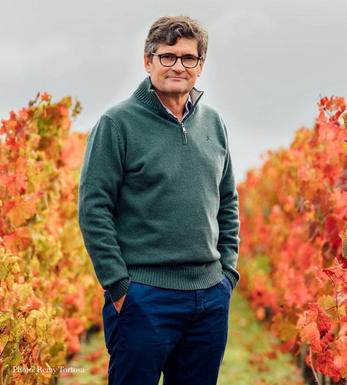
2020 Château Brane-Cantenac, Margaux, Bordeaux

Critics reviews
Drink from 2027 to 2057
Neal Martin, Vinous (May 2021)
Drink from 2028 to 2050
Antonio Galloni, Vinous (June 2021)
Drink from 2028 to 2044
Jane Anson, Decanter (April 2021)
Drink from 2024 to 2040
Lisa Perrotti-Brown MW, Wine Advocate (May 2021)
Drink 2026 - 2042
James Lawther MW, JancisRobinson.com (April 2021)
James Suckling (April 2021)
Drink 2028 - 2040
Michael Schuster, The World of Fine Wine (May 2021)
About this WINE

Chateau Brane-Cantenac
Château Brane-Cantenac was for many years the home of Lucien Lurton - it is now owned and run by his son Henri. Its vineyards are located west of the village of Cantenac in the Margaux appellation. Brane-Cantenac's vineyards are planted with Cabernet Sauvignon (55%), Merlot (40%), Cabernet Franc (4.5%) and Carmenère 0,5%, and lie on fine, gravelly soils. Vinification includes up to 18 months' wood ageing, a third to a half in new `barriques'.
Brane Cantenac was perceived throughout much of the 70s and 80s as an underperforming property. Since Henri took over, there has been extensive investment in the cuverie and chai, as well as vastly improved vineyard management techniques. Consequently, the wines at Brane Cantenac now show more weight and concentration, although they still possess that haunting bouquet and quintessential elegance that characterise the wines of Margaux. It is classified as a 2ème Cru Classé.

Margaux
If Pauillac can be seen as the bastion of ‘traditional’ Red Bordeaux, then Margaux represents its other facet in producing wines that are among Bordeaux’s most sensual and alluring. It is the largest commune in the Médoc, encompassing the communes of Cantenac, Soussans, Arsac and Labaude, in addition to Margaux itself. Located in the centre of the Haut-Médoc, Margaux is the closest of the important communes to the city of Bordeaux.
The soils in Margaux are the lightest and most gravelly of the Médoc, with some also containing a high percentage of sand. Vineyards located in Cantenac and Margaux make up the core of the appelation with the best vineyard sites being located on well-drained slopes, whose lighter soils give Margaux its deft touch and silky perfumes. Further away from the water, there is a greater clay content and the wines are less dramatically perfumed.
Margaux is the most diffuse of all the Médoc appelations with a reputation for scaling the heights with irreproachable wines such as Ch. Margaux and Ch. Palmer, but also plumbing the depths, with too many other châteaux not fulfilling their potential. There has been an upward shift in recent years, but the appellation cannot yet boast the reliability of St Julien. However, the finest Margaux are exquisitely perfumed and models of refinement and subtlety which have few parallels in Bordeaux.
Recommended Châteaux: Ch. Margaux, Ch. Palmer, Ch. Brane-Cantenac, Ch. Rauzan-Ségla , Ch. Dufort-Vivens, Ch. Ferrière, Ch. du Tertre, Ch. Giscours, Ch. d'Angludet.

Cabernet Sauvignon Blend
Cabernet Sauvignon lends itself particularly well in blends with Merlot. This is actually the archetypal Bordeaux blend, though in different proportions in the sub-regions and sometimes topped up with Cabernet Franc, Malbec, and Petit Verdot.
In the Médoc and Graves the percentage of Cabernet Sauvignon in the blend can range from 95% (Mouton-Rothschild) to as low as 40%. It is particularly suited to the dry, warm, free- draining, gravel-rich soils and is responsible for the redolent cassis characteristics as well as the depth of colour, tannic structure and pronounced acidity of Médoc wines. However 100% Cabernet Sauvignon wines can be slightly hollow-tasting in the middle palate and Merlot with its generous, fleshy fruit flavours acts as a perfect foil by filling in this cavity.
In St-Emilion and Pomerol, the blends are Merlot dominated as Cabernet Sauvignon can struggle to ripen there - when it is included, it adds structure and body to the wine. Sassicaia is the most famous Bordeaux blend in Italy and has spawned many imitations, whereby the blend is now firmly established in the New World and particularly in California and Australia.


Buying options
Add to wishlist
Description
This is a wonderful amalgam of the vintage signatures and the Henri Lurton style. The flavours are pure and full, but there is restraint, too. The fruit is sweetly ripe, with cassis. The palate imprint is not at all heavy; there is a fine line of precision, and a final focus on bright, pure ripe fruit. There is a suggestion of vanilla and the tannins are correct, with just enough tension. The 1% Carmenère is notable, a Bordeaux rarity nowadays. Henri trusts it to add complexity and spice.
We recently spoke to Henri Lurton for some insight into the unique terroir of Brane, and the nature of the 2020 vintage. You can read the interview here.
Drink 2027-2045
wine at a glance
Delivery and quality guarantee